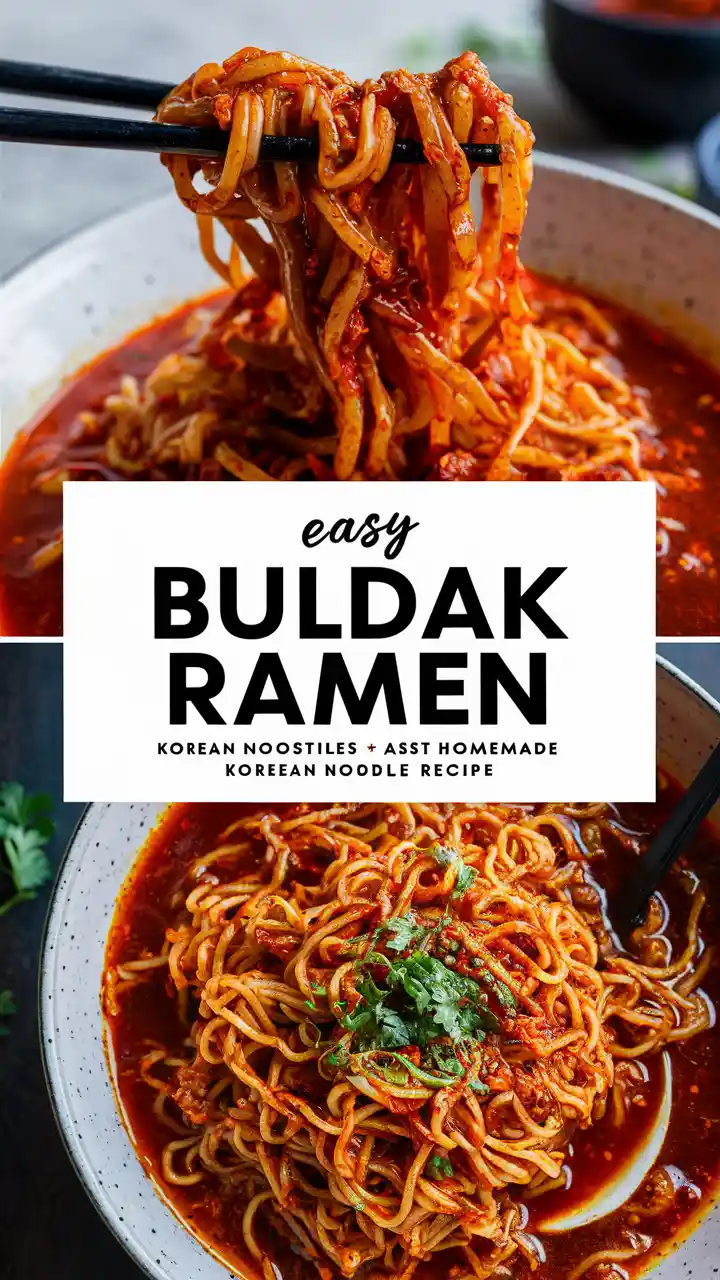If you love spicy food, you’ve probably heard of Buldak Ramen (불닭 라면), also known as Korean Fire Noodles. Famous for its intense heat and addictive flavor, this dish has captured the hearts of spice lovers around the world. What started in South Korea as a bold, fiery street-food creation has now become a viral global trend — thanks to YouTube challenges and the iconic Samyang instant ramen.
But Buldak Ramen is more than just a viral dare; it’s a dish full of depth, balance, and customization. By making it at home, you can control the spice level, add nourishing ingredients, and transform it into a hearty meal tailored to your taste.
In this guide, we’ll cover:
- The cultural roots of Buldak Ramen
- Essential ingredients (and why they matter)
- Step-by-step cooking instructions
- Tips to adjust spice levels
- Nutritional and health-friendly variations
- Serving ideas and expert FAQs
Let’s dive into the fiery world of homemade Buldak Ramen!
🌶️ The Story Behind Buldak Ramen
“Buldak” literally translates to “fire chicken” in Korean. It originated in the early 2000s as a stir-fried chicken dish coated in a fiery sauce made from gochujang (Korean chili paste) and gochugaru (Korean chili flakes). When Samyang introduced the Buldak Bokkeum Myeon (Hot Chicken Flavor Ramen) in 2012, it quickly became a global sensation, sparking the now-famous “Fire Noodle Challenge.”
At its core, Buldak Ramen represents the Korean love for bold flavors — balancing spice, umami, and a touch of sweetness.
🥢 Ingredients You’ll Need
Here’s what makes a perfect bowl of Buldak Ramen:
For the Noodles
- 2 packs Korean-style instant ramen (chewy texture works best)
- 2 cups water
For the Buldak Sauce
- 2 tbsp gochujang (Korean chili paste) – deep, fermented spice
- 1 tbsp gochugaru (Korean chili flakes) – adds smokiness
- 2 tbsp soy sauce – umami base
- 1 tbsp honey or brown sugar – balances the heat
- 1 tbsp sesame oil – nutty aroma
- 2 cloves garlic (minced) – pungent kick
- ½ tsp fresh ginger (grated) – warmth and depth
- ½ cup chicken broth (or vegetable broth for vegetarian version)
Optional Add-ins & Toppings
- ½ cup grilled chicken, shrimp, or tofu
- 1 tbsp butter (for creamier texture)
- 1 soft-boiled egg (halved)
- 1 tbsp toasted sesame seeds
- 1 green onion (finely chopped)
- 1 sheet of nori (seaweed), sliced into strips
- ½ cup shredded cheese (for the popular cheesy version)
👩🍳 Step-by-Step Instructions
Step 1: Cook the Noodles
- Boil 2 cups of water in a medium pot.
- Add ramen noodles and cook for 3–4 minutes until slightly chewy (al dente).
- Drain, reserving ¼ cup of the cooking water. Set noodles aside.
Step 2: Prepare the Fiery Sauce
- In a small pan, heat sesame oil.
- Sauté garlic and ginger for 30 seconds until fragrant.
- Add gochujang, gochugaru, soy sauce, honey, and broth.
- Simmer 2–3 minutes until slightly thickened.
Step 3: Combine & Toss
- Return noodles to the pot.
- Pour sauce over noodles and toss on low heat until fully coated.
- Add a splash of reserved noodle water if needed for silkier texture.
Step 4: Serve & Garnish
- Transfer to a deep bowl.
- Top with soft-boiled egg, sesame seeds, scallions, and nori strips.
- Add cheese or butter for a creamier twist.
🔥 Adjusting Spice Levels
| Spice Level | How to Adjust |
|---|---|
| Mild | Use half the gochujang/gochugaru; add cream or cheese |
| Medium | Follow the recipe as-is |
| Hot | Double gochugaru or add fresh chili slices |
| Extreme | Use extra chili oil or a splash of hot sauce |
Pro Tip: Balance heat with richness — butter, cheese, or coconut milk can tone down the burn without losing flavor.
🥗 Nutrition & Health Insights
A typical serving of Buldak Ramen can be high in sodium and calories, but homemade versions let you make it healthier:
- Use whole-wheat or rice noodles for added fiber.
- Add spinach, mushrooms, or bok choy for nutrients.
- Swap chicken broth for low-sodium vegetable broth.
- Use lean proteins (shrimp, chicken breast, or tofu).
Capsaicin, the compound in chili peppers, also boosts metabolism and releases endorphins, making this dish both exciting and mood-lifting.
🍱 Serving Suggestions
Make it a complete Korean meal with:
- Kimchi (fermented cabbage) – tangy, probiotic-rich
- Pickled radish (danmuji) – crunchy, refreshing
- Korean fried chicken – crispy, savory balance
- Boricha (barley tea) or soju – to cool the spice
🌍 Creative Variations
- Cheese Buldak Ramen → Melt shredded mozzarella on top.
- Seafood Fire Noodles → Add shrimp, squid, or mussels.
- Vegetarian Buldak Ramen → Swap chicken broth for miso broth + tofu.
- Fusion Style → Toss in parmesan and cream for a Korean-Italian mashup.
❓ Expert FAQs
Q: Can I make Buldak Ramen less salty?
Yes — use low-sodium soy sauce or make your own broth instead of using flavor packets.
Q: Can I meal prep this dish?
Yes — store the sauce separately and toss with fresh noodles when ready to serve.
Q: Is it possible to make this halal/kosher?
Absolutely — just ensure your noodles, soy sauce, and gochujang are certified.
Q: Can I make a dairy-free version?
Yes — skip cheese and use coconut milk for creaminess.
✅ Final Thoughts
Buldak Ramen is more than just a spice challenge — it’s a flavorful, customizable dish that brings the heart of Korean street food into your kitchen. By making it at home, you can adjust the heat, experiment with toppings, and even make healthier versions without losing that signature fiery kick.
So grab your gochujang, get your noodles ready, and enjoy the thrill of homemade Korean Fire Noodles — bold, comforting, and unforgettable.

